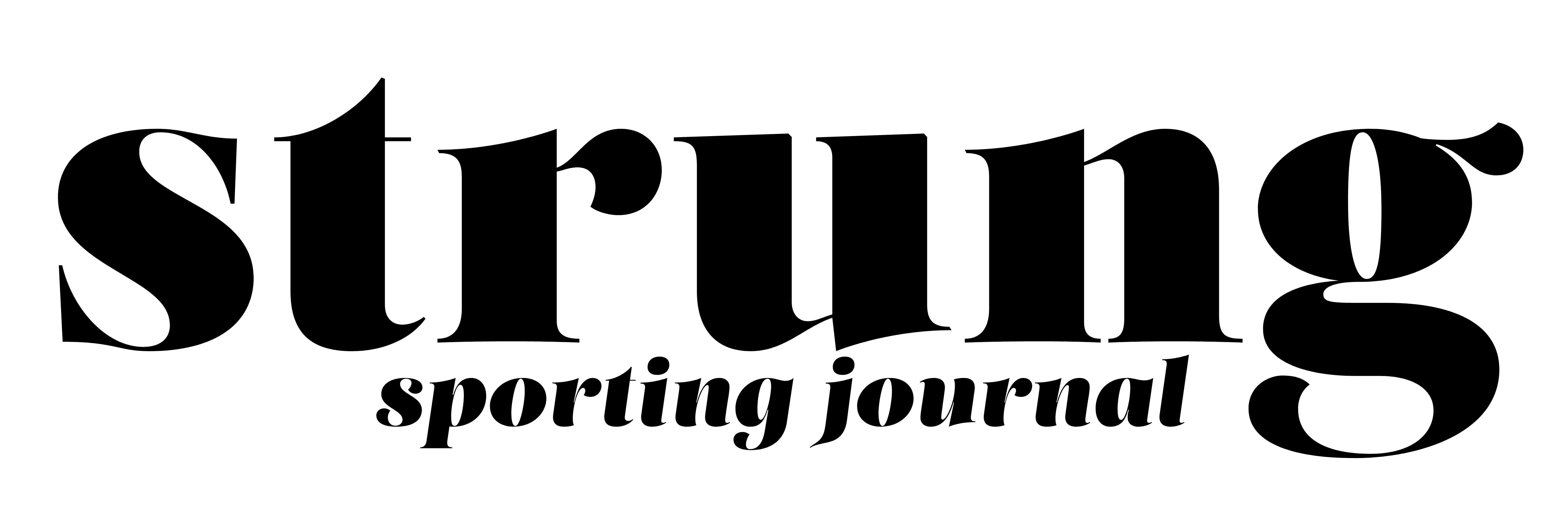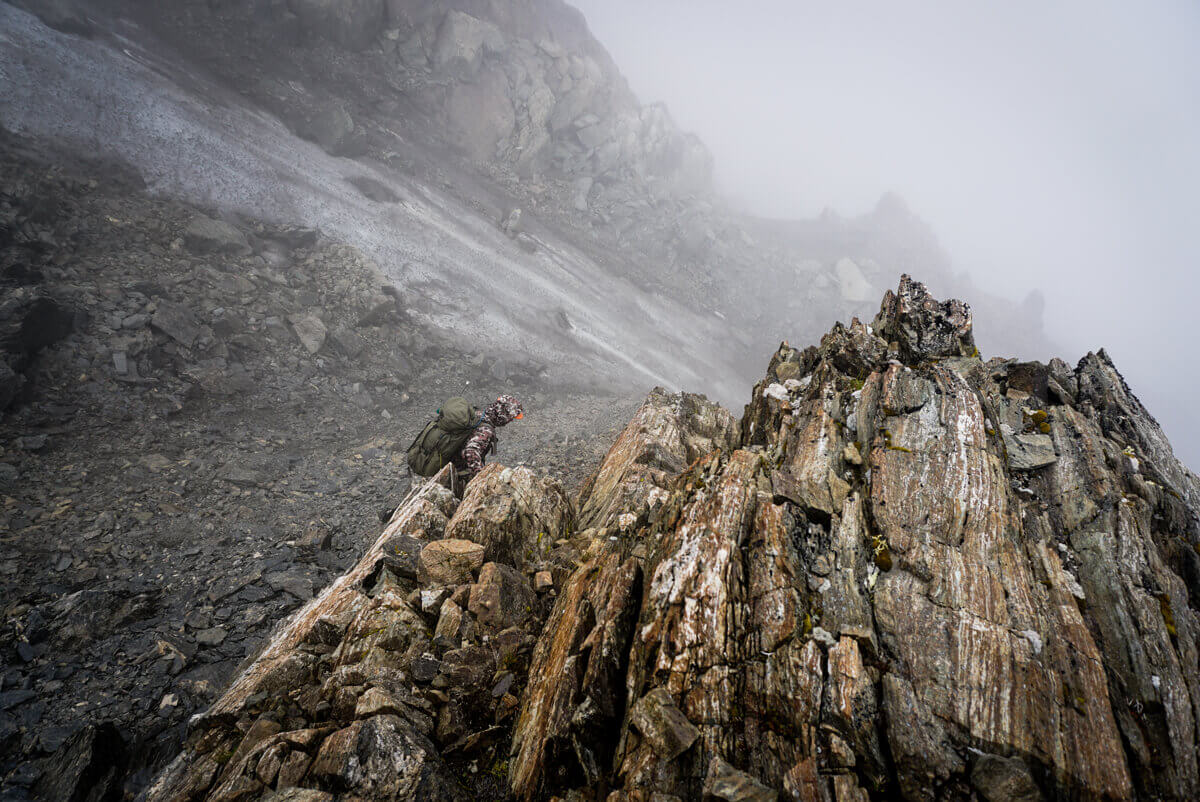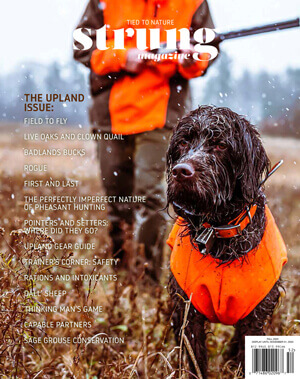No Such Thing as Easy.
Adrenaline coursed through my veins, but was quickly replaced by a sense of grip—that familiar feeling that years of rock climbing had prepared me for, an impression of the consequence and exposure that go hand in hand when traveling in no-fall zones. We were descending from a mountaintop perch into a bowl where my hunting partner Peter and I expected to find a Dall ram waiting in the rocks below. Rather than take the long, reasonable way down, I convinced Peter that the direct route down a steep chute was possible.
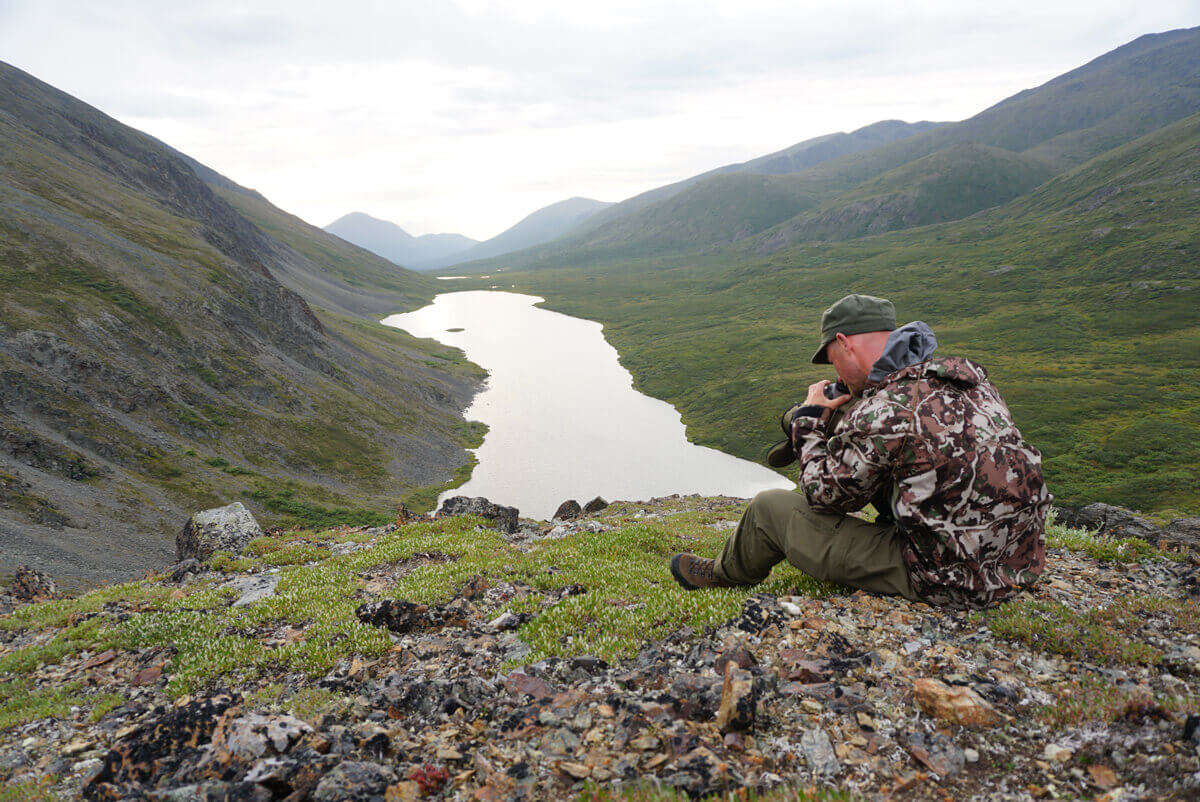 The chilly August weather was slowly melting a large patch of snow and ice at the top of the chute, sending a stream into the gravel-sized scree below. The result was a flowing emulsion that sent the whole chute moving as soon as we set foot in it. Rather than be caught in an avalanche of rubble, we attempted to down-climb the margins, hugging the chausey rock walls, which dislodged and crumbled just as quickly. Peter took the lead, climbing across a precipice and then traversing the scree chute. The route promptly crumbled behind him and rolled down the mountain as he took refuge in a safe alcove.
The chilly August weather was slowly melting a large patch of snow and ice at the top of the chute, sending a stream into the gravel-sized scree below. The result was a flowing emulsion that sent the whole chute moving as soon as we set foot in it. Rather than be caught in an avalanche of rubble, we attempted to down-climb the margins, hugging the chausey rock walls, which dislodged and crumbled just as quickly. Peter took the lead, climbing across a precipice and then traversing the scree chute. The route promptly crumbled behind him and rolled down the mountain as he took refuge in a safe alcove.
He had now descended through the worst of the chute but looked back up at me and shouted, “I wouldn’t want to do that again!”
“How bad was your route?” I yelled back.
“Really bad,” shouted Peter, “but it doesn’t matter. I don’t think it exists anymore.”
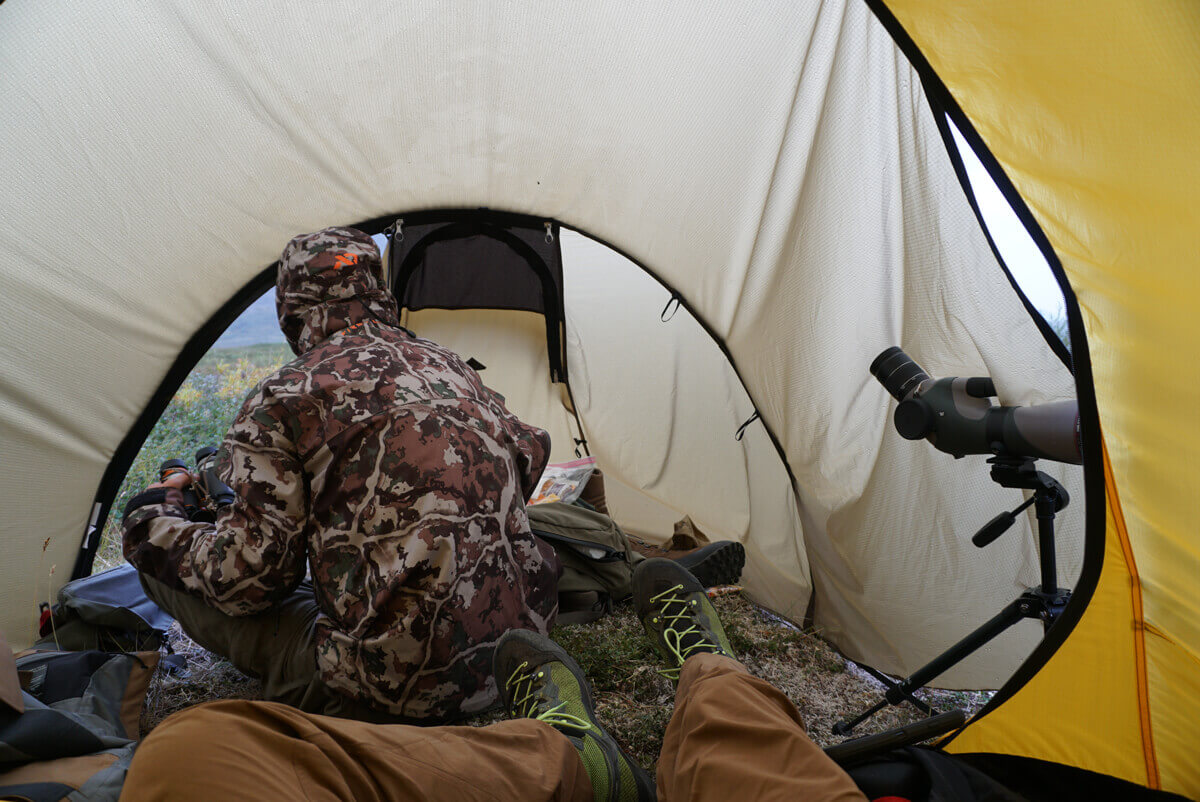 At this point the adrenaline was gone, and I was left shivering on the side of the crumbling mountain. The route down now seemed too risky. Reluctant to continue down but forced to make a move, I decided to bail on the descent and climb back out. Sticking to more solid material seemed safest, and I started climbing the face of the chute wall. I felt more confident moving up the cliff, deliberately placing each foot and testing every handhold before committing my body weight. We were 20 miles by foot from the truck; this was no place for a misplaced foot or handhold. The rifle and backpack were cumbersome, but it felt good to be moving up the wall. Though I have largely given up rock climbing, the movement was familiar. I quickly made progress and regained the ridge top where we had spent a few anxious hours earlier, patiently waiting for a shot opportunity.
At this point the adrenaline was gone, and I was left shivering on the side of the crumbling mountain. The route down now seemed too risky. Reluctant to continue down but forced to make a move, I decided to bail on the descent and climb back out. Sticking to more solid material seemed safest, and I started climbing the face of the chute wall. I felt more confident moving up the cliff, deliberately placing each foot and testing every handhold before committing my body weight. We were 20 miles by foot from the truck; this was no place for a misplaced foot or handhold. The rifle and backpack were cumbersome, but it felt good to be moving up the wall. Though I have largely given up rock climbing, the movement was familiar. I quickly made progress and regained the ridge top where we had spent a few anxious hours earlier, patiently waiting for a shot opportunity.
In my experience, a hike-in sheep hunt can be more of a backpacking trip than a typical hunt. Animals do not densely populate the mountains, and you must travel far to find them. This isn’t a bad thing, because to follow sheep you have to go into the mountains—and what better place to spend your time putting one foot in front of the other?
Our trip started from the road, where we loaded our gear onto homemade pack wheels assembled from spare bicycle parts in my garage. If the terrain allows, pack wheels are a boon to carrying weight into the backcountry: They increased our speed, and at the end of the first day, we shouldered our fully loaded packs for the first time, now 10 miles from the truck. Rather than feeling tired and done for the day, our backs were fresh and ready to push on, enabling us to go the extra distance needed to find sheep.
Alaska’s summer weather offers no guarantees. I’ve been snowed on in August, shivering through long glassing sessions and trying to pick out white sheep in a landscape blanketed in snow. Rain is often the norm, and one can expect to be weathered in, forced to hunker down and take refuge in the tent. When the clouds roll down the valleys and visibility disappears, the only thing to do is catch up on sleep or school your partner in cribbage.
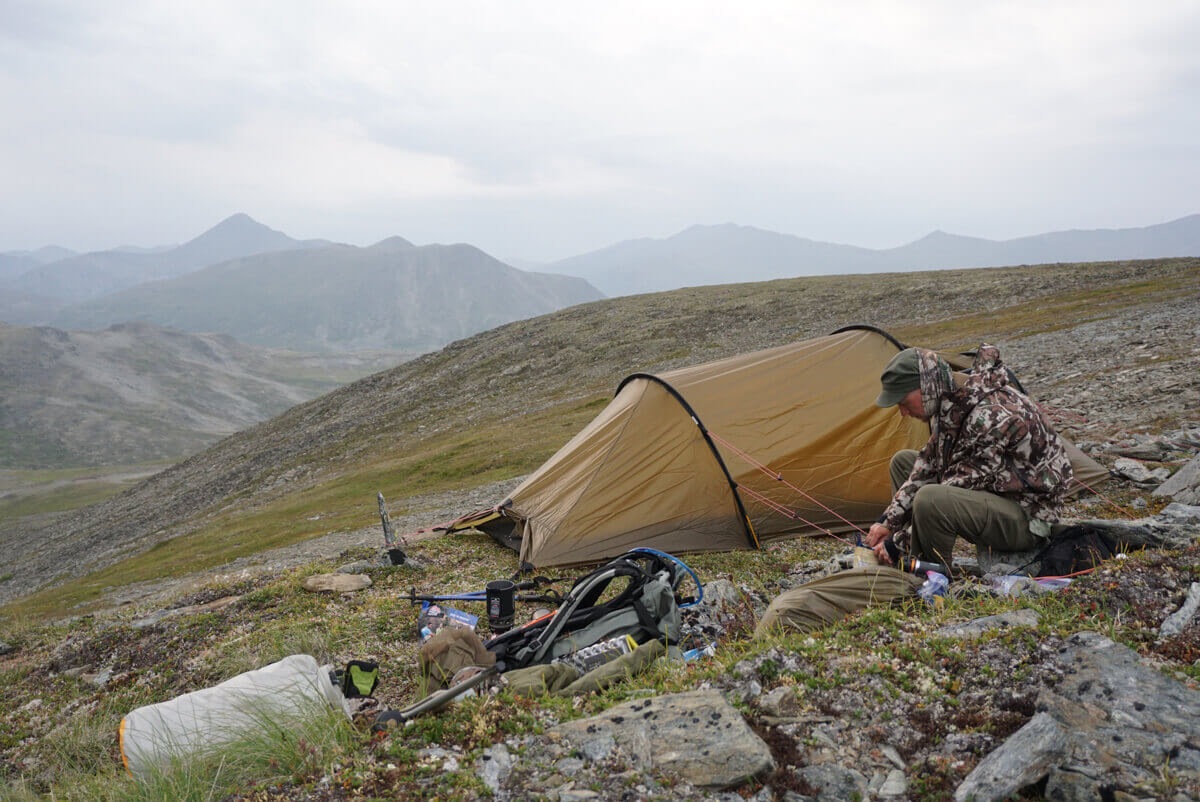 This particular summer was different: We were blessed with sunshine and warm temperatures. Blue skies and t-shirt weather made for easy glassing and travel. We took our time, using binoculars and spotting scope to pick apart each mountainside and valley, hoping for a telltale glimpse of white. With no sign of sheep, we pushed deeper into the backcountry.
This particular summer was different: We were blessed with sunshine and warm temperatures. Blue skies and t-shirt weather made for easy glassing and travel. We took our time, using binoculars and spotting scope to pick apart each mountainside and valley, hoping for a telltale glimpse of white. With no sign of sheep, we pushed deeper into the backcountry.
Hunting promotes wonder and observation. Rarely do I exercise my senses to such a degree in other pursuits. Musty smells suddenly pique a hunter’s interest, betraying the past movements of animals. A distant bugle or scrape of hoof on rock quickens the pulse. Hunting imparts a heightened sense of meaning to what would otherwise be a backpacking trip—and by all accounts, we were having a glorious backpacking trip. We hiked and glassed for days, finding massive bull moose and brown bears. We swam in turquoise lakes, climbed mountains, and traversed rocky ridge tops. We both agreed that the trip was shaping up to be one of the most pleasant backcountry journeys either of us had experienced in Alaska. We spotted numerous sheep, but none old and large enough to be considered legal.
Finally the weather changed, and the rain and fog stirred the sheep from their lofty cliffs. The morning of the fifth day brought rain and clouds, prompting us to lounge in the tent and sip instant coffee while making plans for the day. From the vestibule of the tent, I glimpsed something unexpected: six Dall rams descending the mountain above camp. They came lower and lower, eventually to within shooting distance. We were pinned down in the tent, which was now functioning as a blind. From the vestibule door, I trained the spotting scope on the rams. None appeared to be legal, but it was hard to tell as they were on the move and never provided a steady, broadside view. We watched as they crossed the valley and climbed the opposite mountainside. Finally, the last ram stopped and turned his head.
“He might be legal,” said Peter.
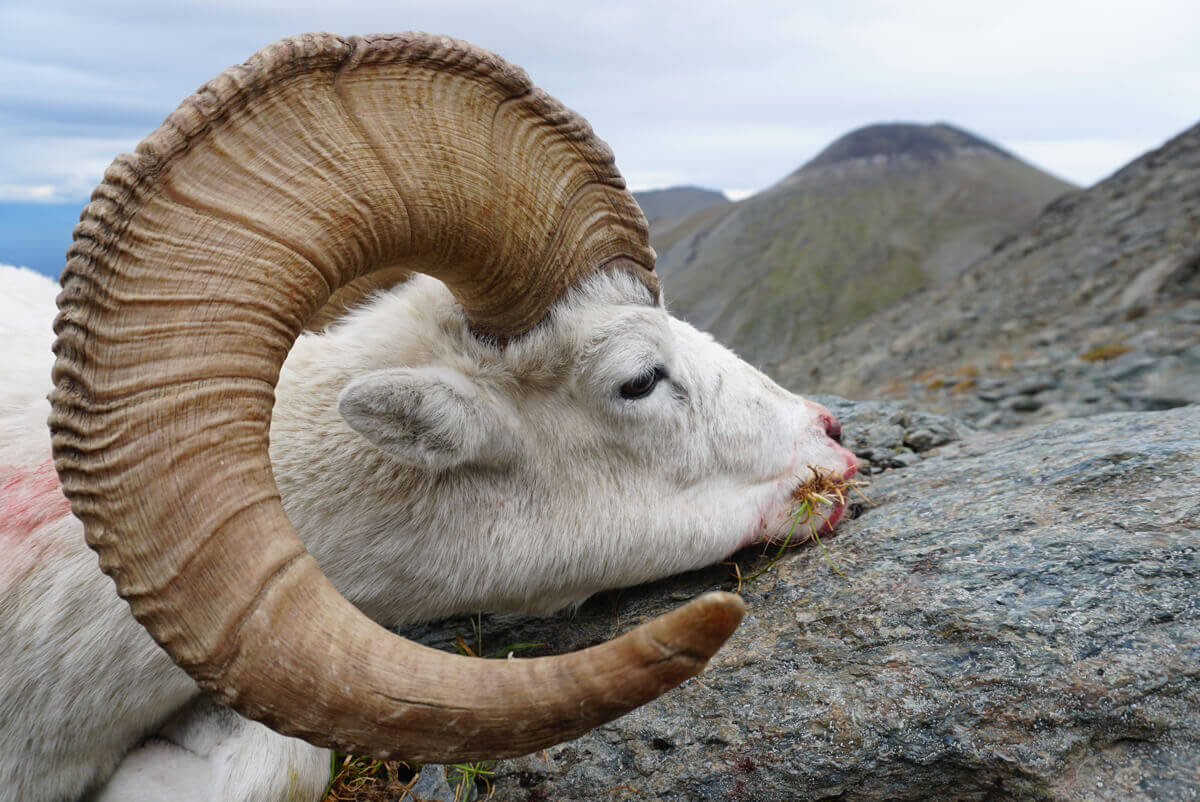 Brian Ohlen grew up fly fishing and deer hunting in the Black Hills of South Dakota. The scent of sagebrush drew him west, where ever-larger rivers and mountains stoked his desire to explore. He received a Bachelor of Science from the University of Idaho and has worked across the west as a bicycle mechanic, logger, trail builder, and writer. Brian currently resides in Alaska where he revels in the ability to fill freezers full of wild berries, fish, mushrooms, and game. His freelance work has appeared in Backcountry Journal, Strung Magazine, and for many outdoor gear brands. You can follow his work @spoke_n_fly or at spokenfly.com
Brian Ohlen grew up fly fishing and deer hunting in the Black Hills of South Dakota. The scent of sagebrush drew him west, where ever-larger rivers and mountains stoked his desire to explore. He received a Bachelor of Science from the University of Idaho and has worked across the west as a bicycle mechanic, logger, trail builder, and writer. Brian currently resides in Alaska where he revels in the ability to fill freezers full of wild berries, fish, mushrooms, and game. His freelance work has appeared in Backcountry Journal, Strung Magazine, and for many outdoor gear brands. You can follow his work @spoke_n_fly or at spokenfly.com
